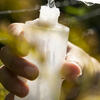Research Facilities
The primary College of Science and Technology research facilities on Main Campus are housed in
- the Biology-Life Sciences Building for the Biology Department;
- Beury Hall for the Chemistry and Earth and Environmental Science departments; and
- the Science Education and Research Center (SERC), the College of Science and Technology's most advanced facility completed in 2014, for portions of the Biology and Chemistry departments, as well as the Computer and Information Sciences and Physics departments.
The instrumentation housed in the Biology-Life Sciences Building, Beury Hall and SERC is available for use by undergraduate research students subject to proper training and supervision by faculty, graduate students or postdoctoral researchers.
Undergraduate students of Temple’s College of Science and Technology also have the opportunity to perform research at the Lewis Katz School of Medicine under the direction of medical school faculty and thus have access to additional facilities and instrumentation.
Learn more about research in the College of Science and Technology.

